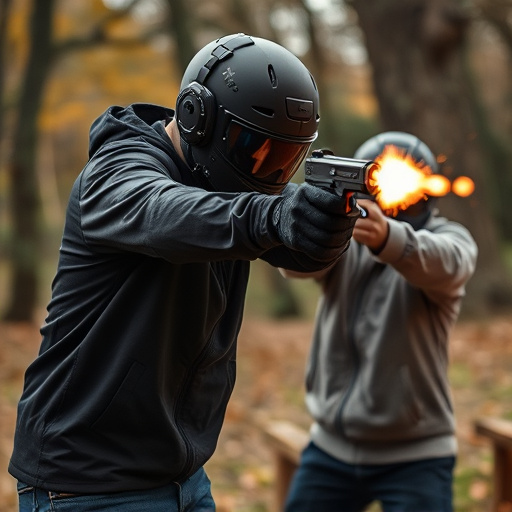Stun guns, designed for self-defense, operate by delivering high-voltage electrical discharges through metal probes, temporarily paralyzing muscles and overwhelming nerve signals. Their safety switch is a critical component that prevents accidental activation and mitigates potential neurological side effects like disorientation, balance loss, and memory lapses. While effective, users must be aware of risks, handle stun guns with caution, and ensure the safety switch is engaged when not in use to minimize adverse reactions. Regulatory bodies worldwide are imposing stricter guidelines on manufacturers, encouraging the development of advanced safety switches and less harmful alternatives through ongoing research into stun gun neurological impacts.
“Unveiling the intricacies of stun gun safety: A comprehensive guide. Stun guns, designed as powerful self-defense tools, operate through a unique activation mechanism. However, their effectiveness and user safety are intrinsically linked to the often overlooked safety switch. This article delves into the critical function of this switch, exploring its role in mitigating potential neurological side effects associated with stun gun usage. We’ll navigate through best practices for users and regulatory aspects, offering insights into the future of stun gun technology.”
- Understanding Stun Gun Activation Mechanism
- The Role of the Safety Switch: A Protective Measure
- Potential Neurological Side Effects of Stun Guns
- Mitigating Risks: Best Practices for Users
- Regulatory Considerations and Future Innovations
Understanding Stun Gun Activation Mechanism

Stun guns, also known as electronic control devices (ECDs), operate on a simple yet powerful principle. When activated, they deliver a high-voltage, low-current electrical discharge that overrides the nerve signals to the muscles, causing temporary incapacitation. This disruption is achieved through a specialized activation mechanism that includes a safety switch and a trigger. Understanding how this process works is crucial for users to comprehend the device’s effectiveness and potential side effects, especially its neurological impact.
The stun gun’s activation begins with the safety switch, designed to prevent accidental discharge. It requires a deliberate action, such as pressing a button or pulling a trigger, to activate the device. Once activated, an electrical charge builds up in the stun gun’s capacitors before being released through metal probes into the target’s body. This electric current interferes with the nerve signals, leading to muscle spasms and temporary paralysis. The neurological side effects can include disorientation, loss of balance, and even short-term memory lapses, making it a powerful tool for self-defense against potential attackers.
The Role of the Safety Switch: A Protective Measure

The safety switch on a stun gun serves as a crucial protective measure, designed to prevent accidental activation and its potential neurological side effects. Stun guns, despite their intended use for self-defense, can cause severe physical discomfort and temporary incapacitation through electric shock. However, an integral part of responsible stun gun ownership is understanding and utilizing the safety switch to mitigate these risks.
This switch provides a simple yet effective way to control when the device will deploy its electrical charge. By requiring explicit activation, it reduces the likelihood of unintended use, especially in situations where someone might startle or mishandle the weapon. Moreover, being mindful of this safety feature is essential, as it can help prevent accidental exposure to stun gun shocks, which may lead to temporary neurological impacts, such as muscle spasms, disorientation, and even respiratory distress in severe cases.
Potential Neurological Side Effects of Stun Guns

Stun guns, while effective as personal defense devices, are not without potential risks, particularly when it comes to their impact on the human body. One area of concern is the device’s effect on the nervous system. When activated, stun guns deliver an electric current that overrides the body’s natural electrical signals, leading to muscle disruption and immobilization. However, this sudden jolt can also cause temporary neurological side effects due to the intense voltage coursing through the body.
The intensity of these side effects can vary from person to person, but they may include dizziness, nausea, disorientation, and even seizures. Prolonged exposure or repeated use could potentially lead to more severe consequences. It’s crucial for users to be aware of these risks and handle stun guns with caution, ensuring the safety switch is activated when not in use to minimize any adverse neurological reactions.
Mitigating Risks: Best Practices for Users

When it comes to stun gun activation, understanding and adhering to safety protocols is paramount to mitigate risks associated with neurological side effects. The stun gun, while designed for self-defense, delivers an electric shock that can have potential health implications if not used responsibly. Users must be aware of the risks involved, particularly regarding temporary neurological impacts like disorientation, memory lapses, and muscle weakness.
Best practices for users include receiving proper training, ensuring clear understanding of the device’s functionality, and maintaining a calm mindset during usage. Regularly reviewing safety guidelines and staying informed about potential side effects can help users make informed decisions. Additionally, keeping the stun gun in an easily accessible yet secure location reduces impulsive use, thereby minimizing both risk and accidental activation.
Regulatory Considerations and Future Innovations

Regulatory bodies worldwide are increasingly scrutinizing stun guns due to growing concerns over their potential neurological side effects. As such, manufacturers must adhere to stricter guidelines when designing and implementing safety switches. These regulations aim to ensure that stun devices not only minimize risks but also provide reliable protection for both users and bystanders. Future innovations in stun gun technology may include advanced sensors and smarter controls that adapt to user needs, enhancing safety without compromising effectiveness.
Additionally, ongoing research into the neurological impacts of stun guns is driving development of safer alternatives. By understanding the mechanisms behind stun gun activation and its effects on the body, engineers can create more targeted and less harmful solutions. This shift towards better regulation and innovative design reflects a broader commitment to balancing personal safety with public well-being.
Stun guns, while designed as non-lethal self-defense tools, come with their own set of risks, particularly regarding potential neurological side effects. Understanding the activation mechanism, especially the safety switch, is paramount for users to mitigate these risks. By adhering to best practices and staying informed about regulatory changes, individuals can ensure safer usage of stun guns while navigating the evolving landscape of self-defense technology.
